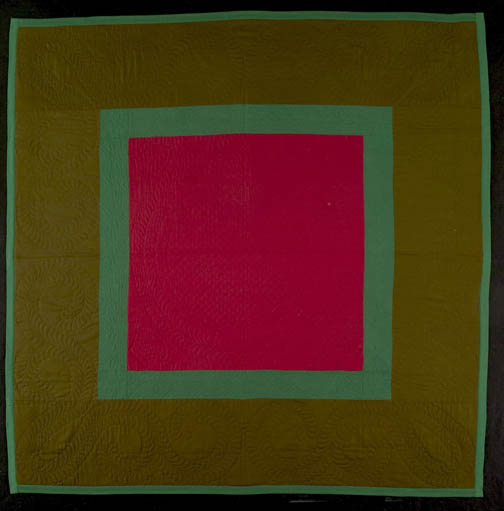Amish quilts!
When I set out to research Amish patchwork traditions for this installment of the blog, I had a lot of preconceived notions of what I’d find. Any quilt anthology worth its salt features one or two Amish center diamond quilts, worked in subdued colors, square and intricately quilted. Even the American Folk Art Museum in NYC has a collection of quilts, with a handful representing the narrow breadth of what we expect of Amish quilts. I did not expect to find quilts of this nature:

Possibly made in Holmes County, Ohio, United States, 1900-20
As it turns out, the Amish arrived at their own form of abstract expressionism, worked in cotton and wool, a handful of decades before the art world. In the mid-1800s, the Amish of Pennsylvania apparently picked up quiltmaking from their neighbors, and began making quilts composed of large fields of color. Latecomers to patchwork in America, the Amish quickly adapted it to their own aesthetic which was, and continues to be, dictated by their religious beliefs. Believing representational images to be sacrilege, Amish quilts are usually abstract and pieced rather than appliqued; the patchwork is kept simple to avoid a prideful display on the part of the maker; fabrics are solid although rarely prints are used as backing. The name of the quiltmaker is generally not known.
Pictured above is a stunning example of a center square quilt from Lancaster County, Pennsylvania, one of the oldest Amish communities in the United States. Antique quilts from Lancaster County are most often constructed of wool, to which we can attribute their radiant glow: wool, unlike cotton, absorbs light. Lancaster County Amish quilts are also generally square in size, consisting of very few pieces (above: nine, plus binding), and tightly and expertly quilted with dark or matching thread that is meant to recede into the quilt. During WWII, when fabric was scarce, we see a shift away from wool textiles in Amish quilts.

Possibly made in PA, Circa 1880-1900, wool.
Above is an interesting variation on the traditional Amish bars quilt: the pink only borders the red bars on three sides, causing the bars to extend all the way to the binding. This is atypical of patchwork, Amish or not, antique or contemporary, and illustrates a subtle commonality among Amish quilts: the desire on the part of the quiltmaker to innovate despite design constraints. True, Amish quilts adhere more stringently to tradition than most other branches of quiltmaking. Considering these many constraints, I posit that the quilt, above, lacking a border on the bottom is a very daring decision–particularly in 1880.

Holmes County, Ohio, 1948, cotton sateen.
The largest Amish community can be found in Holmes County, Ohio, where the above quilt was made. The colors are interesting to me, particularly the pinky-purple against the blue, as is the simplicity of the design. This community is somewhat less strict than that of Lancaster County, a fact which is reflected in the quilts of the area. Holmes County quilts are generally made of cotton or cotton sateen, often utilize a black background, and feature more intricate patchwork and simpler quilting because of the piecing design… the above example notwithstanding. This holds true of many of the midwestern Amish communities, so it seems what we consider a typical Amish quilt is actually typical of the Lancaster County Amish.

Somerset County, PA, circa 1910-30, cotton.
The above quilt is one big log cabin block, and calls to mind the quilts of Gee’s Bend, Alabama, which I’ll discuss in a later post. Considering the isolation of Amish communities, combined with their deeply-held religious beliefs which emphasize the importance of community over the individual, it is no surprise that Amish quilts share a distinct visual language.

Holmes County, Ohio, 1920-40, cotton.
But aren’t these quilts still surprising?

Holmes County, Ohio, circa 1900-20, wool.
The colors used in Amish quilts are the same used in Amish clothing.
Families would buy yardage by the bolt, so although quilts in America during this time period were often constructed from scrap fabric, Amish quilts usually contained a considerable amount of new fabric. Quilts were recognized as heirlooms and only used on special occasions; the Amish of Lancaster County didn’t even make doll or crib quilts. Above is a quilt typical of Holmes County, utilizing black and greys in the background and border.

Possibly made in Indiana, circa 1910-30, cotton sateen.
I found the above quilt to be another interesting cousin to Gee’s Bend quilts: note the improvisationally pieced log cabin blocks! The border is also unusual and reminiscent of the film Beetlejuice.

Midwestern US, circa 1920-40, cotton sateen.
This stacked coin quilt is interesting for the wiggly nature of its strips. Not only are the blue ‘coins’ not uniform in thickness, they are unevenly spaced on a black background.
And finally, pictured above, is my favorite example of an Amish quilt. It is a Roman Stripe or string-pieced quilt, popular during the Great Depression for its economical use of scraps. The strips are of slightly different widths, so that when the blocks are cut, shuffled, and rotated, the black and pink stripes don’t line up perfectly. This gives the composition a great sense of movement, further reinforced by the irregular stripes of the inner border. The quiltmaker arranged the blocks in three vertical rows, causing the blocks to seem to jump from an X shape to a closed diamond shape. This composition is powerful on its own, but takes on new meaning when considered within the context of Amish culture.




This is wonderful. Not what I expected at all – stunning examples of Amish quilts!
Reblogged this on Line, Form, Colour, Texture and commented:
Colourful Amish patchwork…truly unexpected.
Very interesting post!
Very interesting and informative. I had no idea… Excellently written, as well.